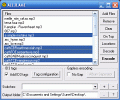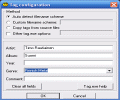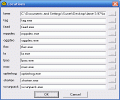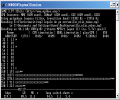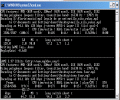To the "unsuspecting" user, the digital audio means just a "thing": music just IS and sounds as you push Play and that's about everything to it. Or so they think... But for all those who have ever ventured in the depths of the digital (multi) media things - whatever they might be - are a whole lot different as notions of maths, physics and informatics are dearly required, let alone the strictly PC-related knowledge base without whose aid everything is in vain.
Until some little time ago, encoding and decoding were terms with very little cover in the real, tactile world as the "devices" and "tools" that were doing these operations were so little accessible to the large masses of PC-users, due to their looks. Of course "looks" is a bit exaggerated as they actually didn't look at all: a DOS-like command prompter simply CAN'T LOOK. Well, it was high time these prompters changed and got a more human-friendly appearance, if not even look appealing: the dawn of the frontends and GUIs for such DOS-y software sparkled and widened, reaching people who - until then - had no idea on what lay behind empty terms like "encode", "attribute", "gap" or "switch".
The Looks
I am not really sure if about a frontend for an audio codec someone could use the term "the looks". Since it is a small window bundled with buttons, all centered on functionality and not at all on graphics, this kind of GUIs are rather hard to review because, even if they lack most of the elements that would usually make us all go "wow!", they are at the same time just great for what they do.
ALL2LAME is a small window whose size you can easily maximize up to the size of your entire desktop and whose largest portion is occupied with the tracklist: the place where you can (starting with this version) drag and drop the files you want to process. The rest of the GUI is simply loaded with all sorts of buttons and fill-in or browse fields: for the output location and the switches (we'll discuss switches in the tech-y part of the present article), the buttons which control the addition and deletion of files to/from the tracklist and so on. Of greater importance are the three buttons which access the Encode and Decode functions as well as the third one which pops up the window containing the location browsers for each coded separately.
As most of you have guessed, ALL2LAME is almost worthless by itself alone, without the proper codecs: you have to indicate the location of these codecs in your PC so that ALL2LAME knew exactly where to go and what to do.
Overall, the frontend for this LAME encoder/decoder in quite nice, without being flashy and definitely without having anything in common with what we might call "graphic design", "GUI concepts" and so on: no color schemes and definitely no skins - just plain classic Windows appearance, the same squared buttons and very readable text on them or wherever need be. Simple and very functional, as ALL2LAME is not a software to enjoy but to work with.
The Works
As well as for the first part, regarding the graphic elements of the ALL2LAME, this technical area of my article will be rather brief as there isn't really much to speak about what an encoder/decoder does, of course if we don't want to become boring and even silly.
In order to operate the ALL2LAME you will be required to know a bit more than simple and basic PC operation such as drag and drop and button-pressing: of course these two are of great importance, but if you want to take full advantage of the capabilities of this program you'll have to learn new things. I guess you already know what I am going to say: SWITCHES.
Switches, a term both very common and at the same time problematic when spoken of in relation with an audio software, are noting more than additional commands and parameters. I searched on the net and soon I discovered exactly what these switches stood for and their use, as well. You will also get familiarized with what they do if you will take a look here. Basically, these are some additional commands without which LAME will work only as it considers it should, while their use will give you control over aspects like bitrate, Kbps and so on. It is neither the place nor the time for me to start explaining which does what; just see the resource above and you'll notice as things start to brighten up.
One last thing, the ALL2LAME will also let you edit the ID3 tags you'd eventually like to associate with your freshly-produced audio; with just a click on the Tag Configuration button you'll be prompted to fill in the required fields so things here simply can't be easier. I'll end up telling you that even if it may seem a bit harder to work with the LAME codec, you'll see that it produces a very Hi-Quality result, no matter the format in which you'll finally save your audio.
The Good
The best thing is that such an interface exists and more people can work with LAME these days. I personally liked it, especially for not trying to look like something it's not and will never be, too: sheer simplicity and high functionality I choose over fancy (but empty) looks.
The Bad
Maybe it won't be such a bad idea to embed some codecs directly into the ALL2LAME and obviously some switches with thorough (or at least, minimal) explanation in the Readme or Help sections.
The Truth
One true thing about the ALL2LAME is that being freeware, you are free to download and use it. Get used to this software and then you'll see how simple, fast and professional you'll be encoding music.
Take a peek at the screenshots of ALL2LAME before you get the software:
 14 DAY TRIAL //
14 DAY TRIAL // 